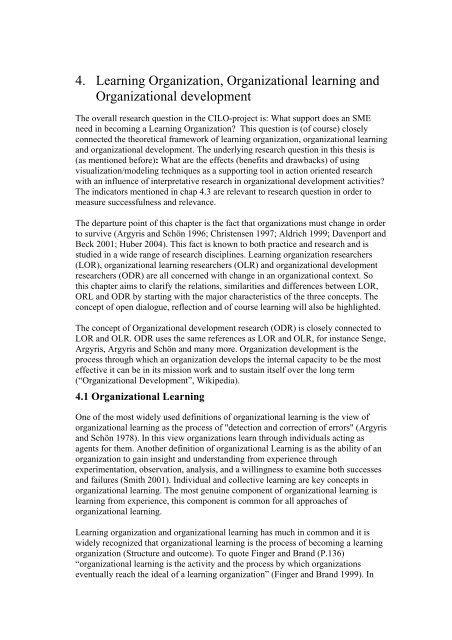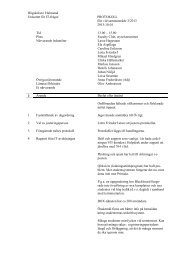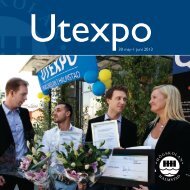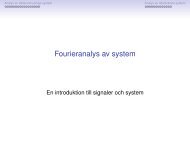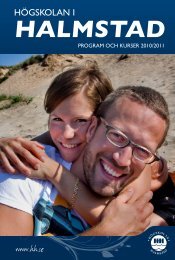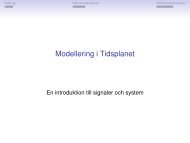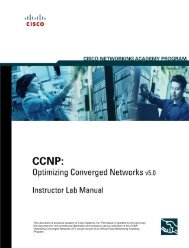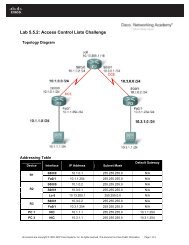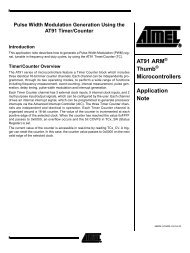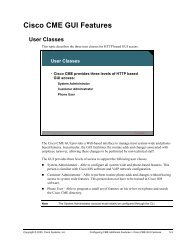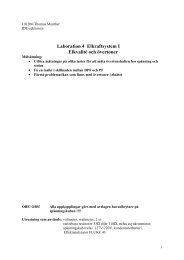4. Learning Organization, Organizational learning and ...
4. Learning Organization, Organizational learning and ...
4. Learning Organization, Organizational learning and ...
Create successful ePaper yourself
Turn your PDF publications into a flip-book with our unique Google optimized e-Paper software.
<strong>4.</strong> <strong>Learning</strong> <strong>Organization</strong>, <strong>Organization</strong>al <strong>learning</strong> <strong>and</strong><br />
<strong>Organization</strong>al development<br />
The overall research question in the CILO-project is: What support does an SME<br />
need in becoming a <strong>Learning</strong> <strong>Organization</strong>? This question is (of course) closely<br />
connected the theoretical framework of <strong>learning</strong> organization, organizational <strong>learning</strong><br />
<strong>and</strong> organizational development. The underlying research question in this thesis is<br />
(as mentioned before): What are the effects (benefits <strong>and</strong> drawbacks) of using<br />
visualization/modeling techniques as a supporting tool in action oriented research<br />
with an influence of interpretative research in organizational development activities?<br />
The indicators mentioned in chap <strong>4.</strong>3 are relevant to research question in order to<br />
measure successfulness <strong>and</strong> relevance.<br />
The departure point of this chapter is the fact that organizations must change in order<br />
to survive (Argyris <strong>and</strong> Schön 1996; Christensen 1997; Aldrich 1999; Davenport <strong>and</strong><br />
Beck 2001; Huber 2004). This fact is known to both practice <strong>and</strong> research <strong>and</strong> is<br />
studied in a wide range of research disciplines. <strong>Learning</strong> organization researchers<br />
(LOR), organizational <strong>learning</strong> researchers (OLR) <strong>and</strong> organizational development<br />
researchers (ODR) are all concerned with change in an organizational context. So<br />
this chapter aims to clarify the relations, similarities <strong>and</strong> differences between LOR,<br />
ORL <strong>and</strong> ODR by starting with the major characteristics of the three concepts. The<br />
concept of open dialogue, reflection <strong>and</strong> of course <strong>learning</strong> will also be highlighted.<br />
The concept of <strong>Organization</strong>al development research (ODR) is closely connected to<br />
LOR <strong>and</strong> OLR. ODR uses the same references as LOR <strong>and</strong> OLR, for instance Senge,<br />
Argyris, Argyris <strong>and</strong> Schön <strong>and</strong> many more. <strong>Organization</strong> development is the<br />
process through which an organization develops the internal capacity to be the most<br />
effective it can be in its mission work <strong>and</strong> to sustain itself over the long term<br />
(“<strong>Organization</strong>al Development”, Wikipedia).<br />
<strong>4.</strong>1 <strong>Organization</strong>al <strong>Learning</strong><br />
One of the most widely used definitions of organizational <strong>learning</strong> is the view of<br />
organizational <strong>learning</strong> as the process of "detection <strong>and</strong> correction of errors" (Argyris<br />
<strong>and</strong> Schön 1978). In this view organizations learn through individuals acting as<br />
agents for them. Another definition of organizational <strong>Learning</strong> is as the ability of an<br />
organization to gain insight <strong>and</strong> underst<strong>and</strong>ing from experience through<br />
experimentation, observation, analysis, <strong>and</strong> a willingness to examine both successes<br />
<strong>and</strong> failures (Smith 2001). Individual <strong>and</strong> collective <strong>learning</strong> are key concepts in<br />
organizational <strong>learning</strong>. The most genuine component of organizational <strong>learning</strong> is<br />
<strong>learning</strong> from experience, this component is common for all approaches of<br />
organizational <strong>learning</strong>.<br />
<strong>Learning</strong> organization <strong>and</strong> organizational <strong>learning</strong> has much in common <strong>and</strong> it is<br />
widely recognized that organizational <strong>learning</strong> is the process of becoming a <strong>learning</strong><br />
organization (Structure <strong>and</strong> outcome). To quote Finger <strong>and</strong> Br<strong>and</strong> (P.136)<br />
“organizational <strong>learning</strong> is the activity <strong>and</strong> the process by which organizations<br />
eventually reach the ideal of a <strong>learning</strong> organization” (Finger <strong>and</strong> Br<strong>and</strong> 1999). In
this sense the <strong>learning</strong> organization is an ideal, ‘towards which organizations have to<br />
evolve in order to be able to respond to the various pressures [they face]” (Ibid<br />
P136). Theorists of <strong>learning</strong> organizations have often drawn on ideas from<br />
organizational <strong>learning</strong> but there has been little traffic in the reverse direction.<br />
One of the main ideas in organizational <strong>learning</strong> is the idea of single-loop <strong>and</strong><br />
double-loop <strong>learning</strong> (Argyris <strong>and</strong> Schön 1978; Argyris <strong>and</strong> Schön 1996). In singleloop<br />
<strong>learning</strong>, individuals, groups, or organizations modify their actions according to<br />
the difference between expected <strong>and</strong> obtained outcomes. In double-loop <strong>learning</strong>, the<br />
entities (individuals, groups or organization) question the values, assumptions <strong>and</strong><br />
policies that led to the actions in the first place; if they are able to view <strong>and</strong> modify<br />
those, then second-order or double-loop <strong>learning</strong> has taken place. Double loop<br />
<strong>learning</strong> is the <strong>learning</strong> about single-loop <strong>learning</strong>.<br />
<strong>4.</strong>2 <strong>Learning</strong> <strong>Organization</strong><br />
The <strong>learning</strong> organization is an ideal organization <strong>and</strong> in order to achieve this sort of<br />
organization Peter Senge (1990) identify five key disciplines that’s need to be<br />
considered: personal mastery; mental models; shared vision; team <strong>learning</strong> <strong>and</strong><br />
systems thinking.<br />
Systemic thinking is the conceptual cornerstone of the <strong>learning</strong> organization; it is<br />
the discipline that integrates the others <strong>and</strong> fusing them into a coherent body of<br />
theory <strong>and</strong> practice (Senge 1994). Systems theory’s ability to comprehend <strong>and</strong><br />
address the whole <strong>and</strong> to examine the interrelationship between the parts provides<br />
solid framework. The concept of relations, control, feedback <strong>and</strong> delays are often<br />
mentioned in order to “see the whole picture”.<br />
Personal mastery. ‘<strong>Organization</strong>s learn only through individuals who learn.<br />
Individual <strong>learning</strong> does not guarantee organizational <strong>learning</strong>. But without it no<br />
organizational <strong>learning</strong> occurs’ (Senge 1990: 139).<br />
Mental models. These are ‘deeply ingrained assumptions, generalizations, or even<br />
pictures <strong>and</strong> images that influence how we underst<strong>and</strong> the world <strong>and</strong> how we take<br />
action’ (Senge 1990: 8).<br />
Team <strong>learning</strong>. Such <strong>learning</strong> is viewed as ‘the process of aligning <strong>and</strong> developing<br />
the capacities of a team to create the results its members truly desire’ (Senge 1990:<br />
236).<br />
Building shared vision. Peter Senge starts from the position that if any one idea<br />
about leadership has inspired organizations for thous<strong>and</strong>s of years, ‘it’s the capacity<br />
to hold a share picture of the future we seek to create’ (1990: 9). Such a vision has<br />
the power to be uplifting – <strong>and</strong> to encourage experimentation <strong>and</strong> innovation.<br />
In the book “The fifth discipline” there is several concepts presented that relates to<br />
the five key disciplines: reflection; transformation; <strong>learning</strong>; exp<strong>and</strong> capacity;<br />
sustainability, employee involvement, shared values <strong>and</strong> open dialogue. Reflection<br />
has its basis in the work of Donald Schön, which has in turn been exp<strong>and</strong>ed on by<br />
Pete Senge (Schön 1983; Senge 1994). The practitioner’s ability to reflect in <strong>and</strong> on<br />
action by turning the mirror inwards in order to bring the internal pictures of the
world to the surface is an important issue. People are viewed as agents able to act<br />
upon the structures <strong>and</strong> systems of which they are a part.<br />
The <strong>learning</strong> organization is presented as an organization that continuously<br />
transforms; continually exp<strong>and</strong> its capacity by continually <strong>learning</strong> activities in<br />
order to reach sustainability in an ever changing market. Team <strong>learning</strong> <strong>and</strong> building<br />
shared vision activities are related to employee involvement, underst<strong>and</strong>ing of<br />
shared values <strong>and</strong> a free flow dialogue.


